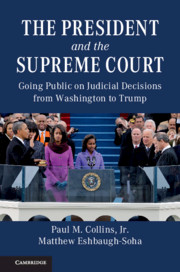Book contents
- The President and the Supreme Court: Going Public on Judicial Decisions from Washington to Trump
- The President and the Supreme Court: Going Public on Judicial Decisions from Washington to Trump
- Copyright page
- Dedication
- Contents
- Figures
- Tables
- Preface
- 1 Going Public and the Supreme Court
- 2 Going Public on Pending Decisions
- 3 Going Public on Decided Cases
- 4 The Tone of Presidential Rhetoric on Supreme Court Decisions
- 5 Presidential Calls to Congress
- 6 Presidential Leadership of News Coverage
- 7 Presidents and Public Opinion
- 8 Going Public on Supreme Court Cases before the Modern Presidency
- 9 Conclusions
- Notes
- References
- Index
2 - Going Public on Pending Decisions
Published online by Cambridge University Press: 13 December 2019
- The President and the Supreme Court: Going Public on Judicial Decisions from Washington to Trump
- The President and the Supreme Court: Going Public on Judicial Decisions from Washington to Trump
- Copyright page
- Dedication
- Contents
- Figures
- Tables
- Preface
- 1 Going Public and the Supreme Court
- 2 Going Public on Pending Decisions
- 3 Going Public on Decided Cases
- 4 The Tone of Presidential Rhetoric on Supreme Court Decisions
- 5 Presidential Calls to Congress
- 6 Presidential Leadership of News Coverage
- 7 Presidents and Public Opinion
- 8 Going Public on Supreme Court Cases before the Modern Presidency
- 9 Conclusions
- Notes
- References
- Index
Summary
Chapter 2 explores the motivations for going public on pending Supreme Court decisions and the effect of these speeches on case outcomes. Though presidents commonly use speeches to shape the actions of Congress and the bureaucracy, this is a risky tactic with regard to the Supreme Court, since it makes the president susceptible to attacks for violating the norm of judicial independence. Moreover, it is not entirely clear why a president would turn to public speeches to influence the justices when the Solicitor General is available to litigate cases or file amicus curiae (“friend of the court”) briefs before the Court on behalf of the administration. We conclude that presidents’ primary motivation to speak about pending cases is not to influence their outcomes, but rather to take public positions that demonstrate their commitment to the policies implicated in the litigation, including shaping how the public understands the constitutional issues involved in the cases.
Keywords
- Type
- Chapter
- Information
- The President and the Supreme CourtGoing Public on Judicial Decisions from Washington to Trump, pp. 27 - 52Publisher: Cambridge University PressPrint publication year: 2020

